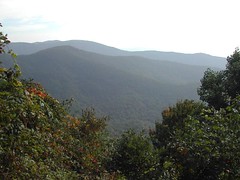Not enough rain for this drought -- and this many people

The view from my window, pictured at right. It has been raining, off and on, since yesterday and may continue awhile. Thank goodness, because the worst drought in over a century around here is showing no signs of relief, and though this rain won't help, it's just good to see wet ground for a change. We needed a few tropical storms to come through this year, but no such luck.(I've posted some photos of the dry situation here, here, and here.)
Georgia -- especially Atlanta -- is in the worst shape. The 5-6 million who live in the area depend mostly on one small river for their water. Of all the places Atlantans could have decided to build on, this must be one of the worst possible choices. The USGS says:
The city of Atlanta developed as a transportation center around the railroads, unlike many large cities which began as ports at the mouths of large rivers. As the railroads were generally built on ridges, Atlanta grew at the intersection of several ridges on the drainage divide between the Atlantic Ocean and the Gulf of Mexico. Consequently, most streams in the Atlanta area are small and many are severely affected by prolonged droughts. The only sizable stream which flows through the metropolitan area is the Chattahoochee River, the headwaters of which are in the mountains of north Georgia. The Chattahoochee River is of marginal size to supply a metropolitan area the size of Atlanta's, and ground-water resources in the area are comparatively limited.
Here's a summary of another USGS report on the Chattahoochee River system, Everybody Lives Downstream. And here's a nice history of the Chattahoochee, from Sherpa Guides.
I read a book -- can't remember which one -- several years ago about the Chattahoochee and the unfortunate burden which Atlanta puts on it. Back then, it was supporting about 3 million people. Is it time for building restrictions? Questions need to be asked, like why Georgia took so long to acknowledge this drought, which has been going on for over a year; and why was development -- including a huge mall --allowed to be built so close to the Lake Lanier dam in Buford? Atlanta's outskirts, of course, are growing too, with commuters building homes closer and closer to the Blue Ridge Mountains, places like Gainesville and Dawsonville and Canton.
Georgians want the federal government to bail them out, which again raises the spectre of dying Apalachicola oysters and the question of Florida's right to some of that water. (Water Wars, Eastern Style). Other alternatives are being discussed too, the news stories say, like running pipelines from the Savannah or Tennessee Rivers. Shades of California and Chinatown.
Of course, California has its own problems beside a short water supply. Increasing population in areas that were once wilderness cause more difficult problems during fire seasons. Floridians found that out a few years back when new homes in forest lands were threatened during a difficult fire season there. And don't get me started on coastal construction in hurricane zones.
Here in the Tennessee Valley watershed, some residents of the mountain regions in the Tennessee Cumberlands and eastern TN and western NC -- some quite close to us -- are dealing with low lake water and empty wells. We worry about our well too. But down along the river, cities like Chattanooga have no water worries so far, and no restrictions. Water has been drained from the upper TVA lakes here in the mountains to keep navigation levels at normal in the Tennessee River. Businesses up here that rely on the lakes for summer income were shut out this year. If Atlanta were allowed to take that water too, how would it affect us?
(Added later:) And, by the way, in case anyone thinks this is just a local, temporary problem, it might be worth looking at Sunday's New York Times Magazine story by Jon Gertner: The Future is Drying Up.
Things would go easier in this country if too many people didn't live in the wrong places. When the majority of the population lived in the northeast and midwest, we only had to deal with blizzards. Now those areas are warmer and more liveable, and relatively underpopulated. Maybe we should start a movement to move back north....
Labels: environment, Florida, Georgia, North Carolina, tennessee





0 Comments:
Post a Comment
<< Home